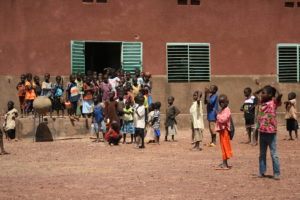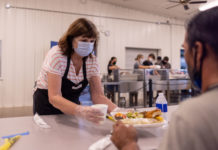
There’s the so-called “school of life.” Then there’s going to school to maintain your livelihood. It seems most of the African children in Burkina Faso fall in the latter category.
We learned this after spending a day at local schools. We managed to visit a campus at every level (I hoped for an honorary diploma by the end) and discovered that education in this country is somewhat about learning, but the bigger motivation, especially for preschool and elementary-aged students, is about getting something to eat.
In school after school, receiving food — lunch while they’re there and sometimes take home rations — seemed to be the key motivator for attendance. We were at a preschool during the lunchtime rush and watched kids eating a corn soy blend. Well, they eventually ate.
A fellow CRS reporter pointed out that we were quite the spectacle and none of the kids seemed to be eating. They had no problem getting their bowl and food, but once they sat on a mat in a big shady area, they were all stares for a bit. About seven photographers — journalists and CRS staff — quietly swarmed around them. The children kept their big dark eyes fixed on us for a bit. After several minutes, their short attention spans returned to food. I think it helped that eh school gave us all a mat to sit on. Suddenly were were on their level and possibly less threatening and maybe less interesting. We started firing questions at the adults.
Just like in America, they said the preschool frees up parents, mothers especially, to focus on daily tasks, like tending to the field so there might be food at home that night. We also visited a primary school. Both are among nearly 700 schools involved in CRS’s Food for Education program. It’s a $16 million effort funded by the USDA and reaches 145,000 students.
Some other tidbits:
- CRS has supported school feeding programs since 1958
- Hot lunche
 s go to 61.800 primary school children
s go to 61.800 primary school children - Take-home rations serve an average of 6,000 girls each month. They must attend 90 percent of the time to receive the rations.
- Health/hygiene are often components of the school meals programs
- Outreach also works to strengthen PTAs, teachers and communities so that everyone is involved in the education process
- In cooperation with three major donors, CRS is constructing 132 girl-friendly schools through this year. It also included a mentor program for the girls.
- Some schools have set up a school canteen or garden to serve as a community access point for food.






